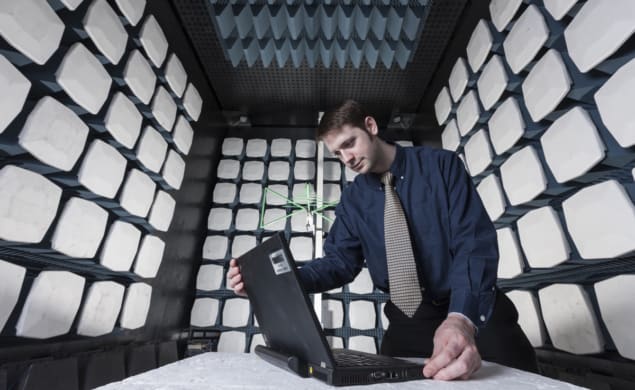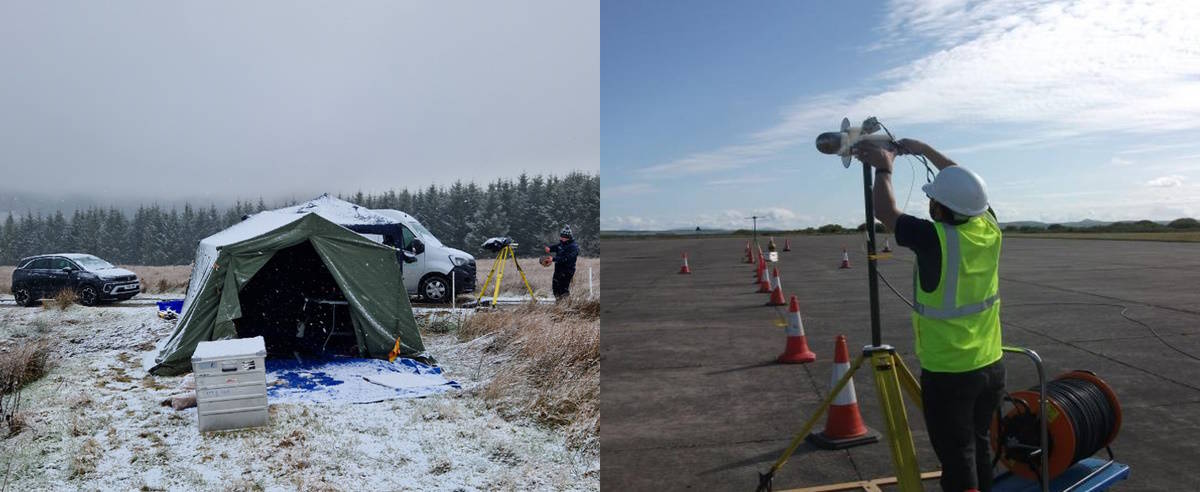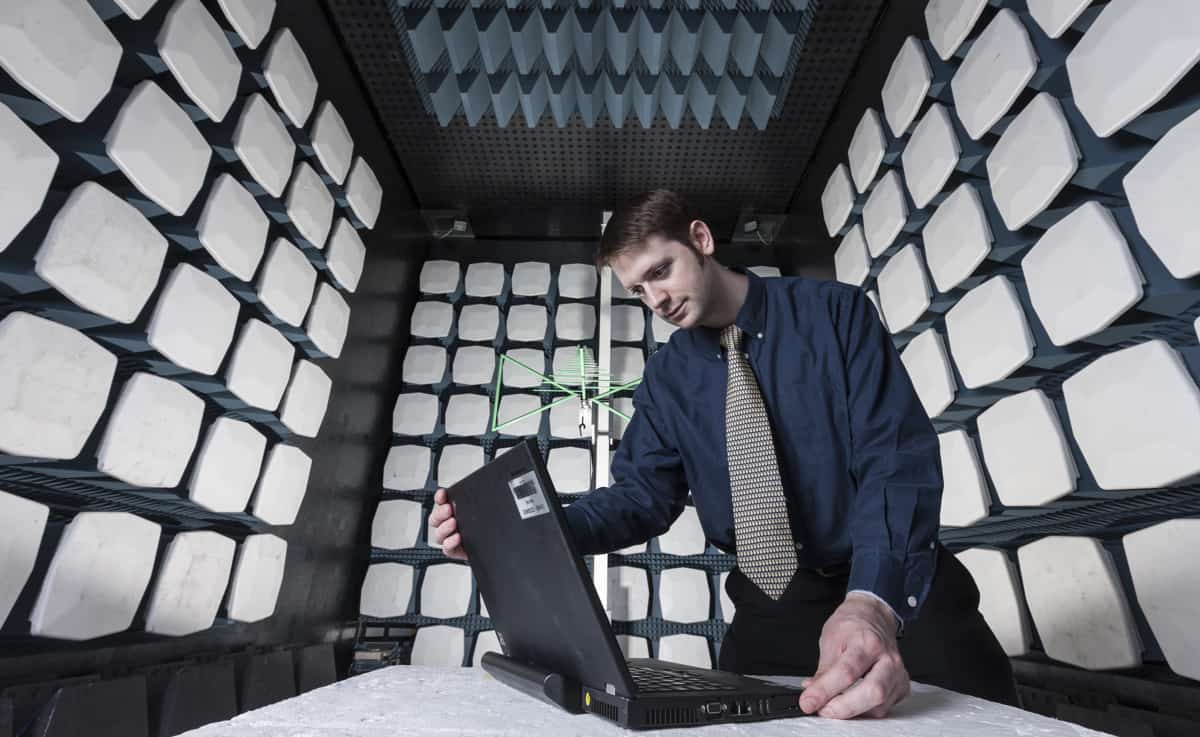The defence and security company QinetiQ is looking for physicists and engineers who are keen to explore the properties of radio waves to solve wireless challenges and create novel solutions

The airwaves that were once dominated by radio and television broadcasts are now buzzing with radiofrequency (RF) signals from mobile phones, satellite links, navigation systems, and much more besides. For the scientists and engineers at QinetiQ, a global defence and security company headquartered in the UK, the RF spectrum is much more than a mere information-carrying resource: they are working to understand the nature of radio waves and their propagation, investigate and exploit the effects of unusual RF environments, and find new ways to manipulate radio waves to design and build innovative wireless systems.
One such example is the development of long-range wireless power transfer, which is being explored by QinetiQ’s technical specialists for providing power in emergency response and disaster relief scenarios, topping up the batteries in drones and other mobile equipment, and even for beaming solar energy generated in space back to Earth. Another focus area is the formulation and testing of novel materials that absorb or reflect radio waves, minimizing the radar profile of military equipment and personnel and so reducing their chance of detection.
“We are looking for scientists and engineers who really want to understand and explore the physics of the RF spectrum,” says Richard Hoad, Global Capability Area Leader within QinetiQ’s Group Technology and Operational Excellence function. “Radio waves are the principal way we communicate and interact with remote platforms, and we are looking for people who want to use their technical knowledge and skills to investigate and develop novel wireless solutions.”

QinetiQ’s activities extend across the full range of radio frequencies and signal strengths, ranging from the low-power radio waves typically used for navigation and communications systems through to defensive platforms that exploit high-power electromagnetic beams to disable electronics and explosive devices, or to disrupt fast-moving vehicles such as drones. As well as finding new ways to use radio waves as a transmission medium, work is also focused on protecting critical radio signals from interference or jamming, preventing extreme RF environments from affecting the performance of electronics equipment, and ensuring that novel RF systems can be operated safely and without affecting the signals used by other wireless technologies.
“Going wireless presents lots of extra challenges that we are constantly working to resolve, such as avoiding interference and managing security risks,” says Hoad. “There is also a trend towards using higher frequencies, up into the terahertz regime, which is pushing the technology boundaries and presenting new and exciting problems for us to work on.”
With several hundred RF specialists working across QinetiQ’s sites in the UK, the US and other international locations, there are plenty of opportunities for its technical specialists to get involved with different projects and problems. “QinetiQ is in many ways a collection of small and specialized teams,” comments Barney Petit, who leads a group in Farnborough, UK, that is investigating the physics-related effects of RF waves. “That allows us to collaborate with colleagues working across a diverse range of technical areas, which makes the work incredibly varied and interesting.”
In many cases the key focus for Petit and his team is to protect critical electronic systems from the effects of unusual RF environments, such as those caused by electromagnetic pulses or solar activity. But they are also working to create novel RF environments for applications such as wireless power transfer or directed-energy systems, with a particular focus on ensuring that these high-power platforms can be deployed safely. “The unusual RF environments created by these systems cannot be assessed in the same way as conventional wireless signals,” says Petit. “We have been working with independent organizations to understand the safety of these systems, and how they can co-exist with other communications and safety-critical electronics technologies.”
Indeed, nearly all of the work for Petit and his team involves some form of collaboration. “We have worked with academic research teams to design some of the antennas we use to simulate these RF environments, plus we provide consultancy services to the commercial sector,” he says. “As an example, we have recently been working with an energy company in Scandinavia to understand how the RF radiation generated by space weather becomes coupled into the long electrical cables in the power infrastructure.”
Most of the projects require some form of lab-based testing, often using semi-anechoic test chambers at Farnborough and occasionally a much larger anechoic chamber, managed by QinetiQ and owned by the Ministry of Defence, that can accommodate an entire aircraft. Sophisticated analytical techniques are also routinely used to make sense of the measurements and develop numerical models of different RF effects and systems.
Outdoor experiments are also needed to test and evaluate emerging wireless technologies, requiring lab results and numerical models to be translated into realistic and real-life exercises that address the specific challenges of each customer. In some cases the specialist skills within the team are also called on to address urgent operational needs, such as one recent requirement to understand and mitigate the coexistence hazards of counter drone systems.

For many technical specialists like Petit, QinetiQ offers the ideal combination of scientific challenge and the opportunity to get involved in a diverse range of projects and tasks. “It’s always different, it’s always interesting, and it’s always challenging,” he says. “The people within QinetiQ are passionate about science and engineering, and they are all focused on understanding and solving problems to drive technical innovation and solve customer problems.”
With the defence and security sector increasingly moving towards wireless technologies, there is growing demand within QinetiQ for physicists and engineers who can probe, evaluate and manipulate the properties of RF waves. “Our work has continued to expand as the world has become more reliant on both wireless and electronics systems,” says Petit. “We have plenty of work for people to do, and we are looking to fill all types of roles across the RF domain.”
While new recruits are unlikely to have direct experience of the specialist work at QinetiQ, scientists with a background in physics or electrical engineering should have the foundational knowledge needed to develop the required experimental and analytical skills. “Our senior scientists and engineers provide on-the-job training to help early-career staff to learn about specific aspects of the work,” explains Petit. “We have recruited people from industry who have experience of RF testing in a research environment, while anyone who has worked with radar is likely to have transferable knowledge and skills.”
Candidates who are only just setting out on their careers are also welcome, particularly those who have had some training in radar or RF engineering. “They might have just finished an apprenticeship, a degree, a Master’s or PhD, and want to come into an organization where they can develop their skills in RF engineering in a science and innovation environment,” says Hoad. “Within QinetiQ they have the flexibility to follow their own interests.”
Recent graduates have the option of joining QinetiQ’s two-year training scheme, in which they are based in a “home” business while taking a series of six-month placements in other areas, or building their skills and expertise within a specific technical team. But anyone in the company has the opportunity to move between different technical areas as their career progresses. “People can move across our broad spectrum of activity,” says Hoad. “Someone might start in high-power RF systems, for example, and then use that knowledge in a team that is working to understand the propagation of radio signals, or vice versa.”
QinetiQ also offers plenty of opportunities for gaining additional academic qualifications and continuing professional development. Hoad started his career as a technical apprentice, studying part-time to obtain first a Master’s and then a doctorate, while Petit is currently being sponsored by QinetiQ to complete a PhD project on wireless power transfer with Queens University Belfast.
Most technical specialists at QinetiQ also aim to become chartered scientists and engineers, with the company providing the support to fund membership fees, identify suitable mentors, and help staff to gain the required skills and experience. “Within QinetiQ you can be in control of your own destiny,” says Hoad. “You can choose to become a deep specialist in a specific RF technology, or you can expand your core skill set by getting involved with different projects and teams. We provide the support for each individual to find and develop their own pathway.”
